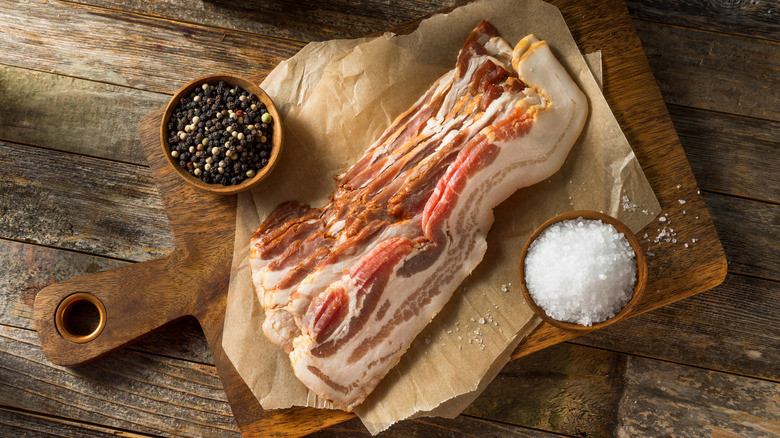The Slight Difference Between Cured And Uncured Meat
If you've ever found yourself standing aimlessly in front of the deli section at the grocery store, you're not alone. Sometimes it seems like there are a dozen choices to make for one meat purchase: salami versus salumi, center versus thick cut, cured versus uncured. To help make your decision process easier, we've broken down the slight difference between cured and uncured meat, so that you can get home to make your breakfast sandwich or bacon-cheddar drop biscuits even faster.
In short, the key difference between cured and uncured meats is how they are preserved. Meats labeled "cured" are preserved using salt and synthetically derived sodium nitrates and sodium nitrites. Meats labeled "uncured" are also, ironically, cured and preserved — though solely with naturally occurring ingredients such as salt or celery powder. Meats can also be cured with naturally occurring nitrates and nitrites from fruits and vegetables, but are still considered "uncured" due to USDA labeling regulations.
Cured meat includes chemical preservatives
Curing meat is nothing new — in fact, the process dates all the way back to 3000 B.C. It was first done using salt to preserve meat through the winter or whenever food was scarce. The salt covering the meat would remove moisture that could lead to bacteria growth and spoilage. Today, the process of curing meat is similar, but it's not just used to preserve; it also adds flavor and an appetizing pink color to the meat. For example, some popular curing flavors for bacon are applewood and hickory.
Meat such as salami, prosciutto, and bacon can be either wet or dry cured, resulting in varying textures and flavors. Wet curing involves the meat being submerged in a liquid brine, while dry-cured meat is dry-rubbed with salt and synthetic sodium nitrites/nitrates. Both processes require at least a few days for preservation to occur.
You may be asking: If cured meat includes synthetic preservatives, should I avoid it? While there is some research suggesting that chemically produced nitrates in processed meat can lead to health risks such as cancer, the answer is not black and white. Both cured and uncured meat contain nitrates and nitrites that can be converted to carcinogenic chemicals when consumed. The slight difference is simply where they are derived from. There is still debate among scientists and medical professionals surrounding chemically produced sodium nitrates and whether they are "less healthy" than naturally occurring nitrates.
Uncured meat is still cured, despite its label
The process of preserving uncured meat is nearly identical to its "cured" counterparts, though with the use of fewer, natural ingredients like celery powder, sea salt, and beetroot extracts. While these uncured meat products are labeled "No Nitrate or Nitrite Added" they can (and likely do) contain naturally occurring nitrites and nitrates.
Besides the different preservation process, uncured meats (such as uncured bacon) are also less pink and have a milder, more natural taste, rather than your classic, salty "bacon" flavor. The shelf life of sealed uncured meat is also about 30 to 50 days shorter than cured meat, and it should be refrigerated and consumed within three to five days of opening. By contrast, sliced cured meats can last for one to two weeks once opened. While uncured meat is certainly a more natural option, whether or not it's the "healthier" or the "right" option is an individual decision for each person. Either way, both cured and uncured meats are delicious and make great additions to your charcuterie board or hearty breakfast platter.



